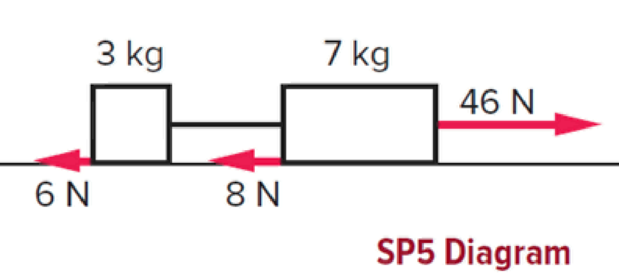
Concept explainers
Two blocks tied together by a horizontal string are being pulled across the table by a horizontal force of 46 N, as shown in the diagram below. The 3-kg block has a 6-N frictional force exerted on it by the table, and the 7-kg block has an 8-N frictional force acting on it.
- a. What is the net force acting on the entire two-block system?
- b. What is the acceleration of this system?
- c. What force is exerted on the 3-kg block by the connecting string? (Consider only the forces acting on this block. Its acceleration is the same as that of the entire system.)
- d. Find the net force acting on the 7-kg block and calculate its acceleration. How does this value compare to that found in part b?

(a)
The net force acting on the entire two-block system.
Answer to Problem 5SP
The net force acting on the entire two-block system is
Explanation of Solution
Given info: The horizontal force acting on
Write the expression for the net horizontal force.
Here,
Total force on the left direction is the sum of
That is,
Substitute
Conclusion:
Thus, the net force acting on the entire two-block system is
(b)
The acceleration of the system.
Answer to Problem 5SP
The acceleration of the system is
Explanation of Solution
Given info: The masses of the blocks are
Write the expression for the acceleration of the horizontal acceleration of the block.
Here,
Total mass of the system is
Substitute
Conclusion:
Thus, the acceleration of the system is
(c)
The force acting on the
Answer to Problem 5SP
The force acting on the
Explanation of Solution
Given info: The horizontal force acting on
Let
Write the expression for the net force on
Here,
Substitute
This net force is acting along the direction of acceleration. That is, along the right direction.
Write the expression for the net force on the
Here,
The negative sign indicate that the force of tension is along the right direction whereas the
Substitute
Therefore, the force acting on the
Conclusion:
Thus, the force acting on the
(d)
The net force and acceleration of
Answer to Problem 5SP
The net force on the
Explanation of Solution
Given info: The horizontal force acting on
Write the expression for the net force on the
Here,
Substitute
Write the expression for the net acceleration on
Here,
Substitute
This is same as the net acceleration obtained in part
Conclusion:
Thus, the net force on the
Want to see more full solutions like this?
Chapter 4 Solutions
Physics of Everyday Phenomena
 Glencoe Physics: Principles and Problems, Student...PhysicsISBN:9780078807213Author:Paul W. ZitzewitzPublisher:Glencoe/McGraw-Hill
Glencoe Physics: Principles and Problems, Student...PhysicsISBN:9780078807213Author:Paul W. ZitzewitzPublisher:Glencoe/McGraw-Hill Physics for Scientists and Engineers: Foundations...PhysicsISBN:9781133939146Author:Katz, Debora M.Publisher:Cengage Learning
Physics for Scientists and Engineers: Foundations...PhysicsISBN:9781133939146Author:Katz, Debora M.Publisher:Cengage Learning College PhysicsPhysicsISBN:9781285737027Author:Raymond A. Serway, Chris VuillePublisher:Cengage Learning
College PhysicsPhysicsISBN:9781285737027Author:Raymond A. Serway, Chris VuillePublisher:Cengage Learning Principles of Physics: A Calculus-Based TextPhysicsISBN:9781133104261Author:Raymond A. Serway, John W. JewettPublisher:Cengage Learning
Principles of Physics: A Calculus-Based TextPhysicsISBN:9781133104261Author:Raymond A. Serway, John W. JewettPublisher:Cengage Learning University Physics Volume 1PhysicsISBN:9781938168277Author:William Moebs, Samuel J. Ling, Jeff SannyPublisher:OpenStax - Rice University
University Physics Volume 1PhysicsISBN:9781938168277Author:William Moebs, Samuel J. Ling, Jeff SannyPublisher:OpenStax - Rice University College PhysicsPhysicsISBN:9781938168000Author:Paul Peter Urone, Roger HinrichsPublisher:OpenStax College
College PhysicsPhysicsISBN:9781938168000Author:Paul Peter Urone, Roger HinrichsPublisher:OpenStax College





